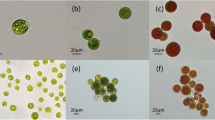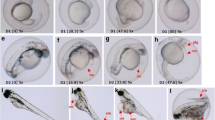Abstract
Gallic and pelargonic acids are naturally found in a variety of plants and food products. Despite their extensive use in man-made applications, little is known regarding their potential risks to aquatic vertebrates. The aim of this work was to assess the acute toxicity of these polyphenolic and fatty acid compounds to the zebrafish. In order to get insights into sublethal effects, the enzyme activity of usual biomarkers related to oxidative stress and biotransformation were also assessed in fish. These latter included total superoxide dismutase, catalase as well as total glutathione peroxidase for antioxidant defence mechanisms and glutathione S-transferase for biotransformation related enzyme. Gallic acid was practically non-toxic (96-h lethal concentration (LC50) > 100 mg/L) whereas pelargonic acid was slightly toxic (96-h LC50 of 81.2 mg/L). Moreover, biomarker analyses indicated enhanced superoxide dismutase activity in fish exposed to 20, 40 and 100 mg/L of gallic acid compared to control. A dose-dependent induction of glutathione peroxidase and glutathione S-transferase was reported following gallic acid exposure at the tested concentrations of 10, 20 and 40 mg/L, with the exception of 100 mg/L of substance where basal activity levels were reported. In the case of pelargonic acid, there was no change in antioxidant enzyme activity while an inhibition of glutathione S-transferase was observed from organisms exposed to 45, 58 and 76 mg/L of test solution. The results concerning sublethal effects on biological parameters of zebrafish highlighted thereby the need for further investigations following chronic exposure to both organic acids.



Similar content being viewed by others
Abbreviations
- CAT:
-
catalase
- CNDB:
-
1-chloro-2,4-dinitrobenzene
- EDTA:
-
ethylenediaminetetraacetic acid
- GPx:
-
glutathione peroxidase
- GST:
-
glutathione transferase
- OECD:
-
Organisation for Economic Co-operation and Development
- MMWD:
-
Marin Municipal Water District
- NADPH:
-
nicotinamide adenine dinucleotide phosphate (reduced)
- SOD:
-
superoxide dismutase
- TOXNET:
-
TOXicology Data NETwork
- US EPA:
-
United States Environmental Protection Agency
References
Beers RF Jr, Sizer IW (1952) A spectrophotometric method for measuring the breakdown of hydrogen peroxide by catalase. J Biol Chem 195:133–140
Bradford MM (1976) A rapid and sensitive method for the quantitation of microgram quantities of protein utilizing the principle of protein-dye binding. Anal Biochem 72:248–254
Brooke LT, D.J. Call, D.T. Geiger, (eds.). CEN (1984) Acute toxicities of organic chemicals to fathead minnows (Pimephales promelas). Superior, WI: Center for Lake Superior Environmental Studies Univ of Wisconsin Superior p. 349
Dena D, Mohd Zobir Bin H, Aminu Umar K, Sharida F, Abdul Halim S, Zalinah A (2012) Preparation of Fe3O4 magnetic nanoparticles coated with gallic acid for drug delivery. International Journal of Nanomedicine 7
Directive 2001/59/CE. Journal officiel no. L 225 du 21/08/2001 p 0001 - 0333
Drotar A, Phelps P, Fall R (1985) Evidence for glutathione peroxidase activities in cultured plant cells, vol 42. Elsevier, Shannon, IRLANDE
European Union (2010) Directive 2010/63/EC of the European Parliament and of the council of 22 September 2010 establishing a new directive on the protection of animals used for scientific purposes
European Food Safety Authority (2013) Conclusion on the peer review of the pesticide risk assessment of the active substance fatty acids C7 to C18 (approved under regulation (EC) no 1107/2009 as Fatty acids C7 to C20). EFSA J 11(1):3023–62 pp. doi:10.2903/j.efsa.2013.3023
Galati G, O'Brien PJ (2004) Potential toxicity of flavonoids and other dietary phenolics: significance for their chemopreventive and anticancer properties. Free Radical Biol Med 37(3):287–303
Gallagher EP, Sheehy KM (2000) Altered glutathione S-transferase catalytic activities in female brown bullheads from a contaminated central Florida lake. Mar Environ Res 50(1–5):399–403
Gatlin DM, Nakagawa H, Sato M, 2007 Dietary supplements for the health and quality of cultured fish. CABI Editions, 244 p
Gil-Longo J, González-Vázquez C (2009) Vascular pro-oxidant effects secondary to the autoxidation of gallic acid in rat aorta. J Nutr Biochem 21(4):304–309
Habig WH, Jakoby WB (1981) Assays for differentiation of glutathione S-transferases. Methods Enzymol 77:398–405
Hamanaka RB, Chandel NS (2010) Mitochondrial reactive oxygen species regulate cellular signaling and dictate biological outcomes. Trends Biochem Sci 35(9):505–513
Hermes-Lima M (2004) In: Storey KB (ed) Oxygen in biology and biochemistry: role of free radicals, in functional metabolism: regulation and adaptation. John Wiley & Sons, Inc, Hoboken. doi:10.1002/047167558X.ch12
Hill AJ, Teraoka H, Heideman W, Peterson RE (2005) Zebrafish as a model vertebrate for investigating chemical toxicity. Toxicol Sci 86(1):6–19. doi:10.1093/toxsci/kfi110
Hoyt C (2009) Rapid, high-throughput homogenization of embryonic or larval zebrafish (Danio rerio). Nature Protocol Exchange
Hsu C-L, Yen G-C (2007) Effect of gallic acid on high fat diet-induced dyslipidaemia, hepatosteatosis and oxidative stress in rats. Br J Nutr 98(04):727–735
Ihunnah CA, Jiang M, Xie W (2011) Nuclear receptor PXR, transcriptional circuits and metabolic relevance. Biochim Biophys Acta (BBA) - Mol Basis Dis 1812(8):956–963
Kamaya Y, Fukaya Y, Suzuki K (2005) Acute toxicity of benzoic acids to the crustacean Daphnia magna. Chemosphere 59(2):255–261
Labieniec M, Gabryelak T, Falcioni G (2003) Antioxidant and pro-oxidant effects of tannins in digestive cells of the freshwater mussel Unio tumidus. Mutat Res/Genet Toxicol Environ Mutagenes 539(1–2):19–28
Labieniec M, Biernat M, Gabryelak T (2007) Response of digestive gland cells of freshwater mussel Unio tumidus to phenolic compound exposure in vivo. Cell Biol Int 31(7):683–690
Lederer B, Fujimori T, Tsujino Y, Wakabayashi K, Böger P (2004) Phytotoxic activity of middle-chain fatty acids II: peroxidation and membrane effects. Pestic Biochem Physiol 80(3):151–156
Liu Y, Li F, Huang Q (2012) Allelopathic effects of gallic acid from. Aegiceras Corniculatum Cyclotella Caspia J Environ Sci 25(4):776–784
Marklund S, Marklund G (1974) Involvement of the superoxide anion radical in the autoxidation of pyrogallol and a convenient assay for superoxide dismutase. Eur J Biochem 47:469–474
Masoud MS, Hagagg SS, Ali AE, Nasr NM (2012) Synthesis and spectroscopic characterization of gallic acid and some of its azo complexes. J Mol Struct 1014:17–25
Maurya H, Mangal V, Gandhi S, Prabhu K, Ponnudurai K (2014) Prophylactic antioxidant potential of gallic acid in murine model of sepsis. International Journal of Inflammation 2014:7 pages
Mitra A, Govindwar S, Kulkarni AP (1991) Inhibition of hepatic glutathione-S-transferases by fatty acids and fatty acid esters. Toxicol Lett 58(2):135–141
MMWD (2008) Marin Municipal Water District Vegetation management plan, Herbicide Risk Assessment. DRAFT-8/28/08. Chapter 7: Pelargonic Acid
Nakai S, Inoue Y, Hosomi M, Murakami A (2000) Myriophyllum spicatum-released allelopathic polyphenols inhibiting growth of blue-green algae Microcystis aeruginosa. Water Res 34:3026–3032
Nakai S, Yamada S, Hosomi M (2005) Anti-cyanobacterial fatty acids released from Myriophyllum spicatum. Hydrobiologia 543:71–78
Nash RDM, Valencia AH, Geffen AJ (2006) The origin of Fulton's condition factor: setting the record straight, vol 31. American Fisheries Society, Bethesda, MD, ETATS-UNIS
Nelson DP, Kiesow LA (1972) Enthalpy of decomposition of hydrogen peroxide by catalase at 25 degrees C (with molar extinction coefficients of H2O2 solutions in the UV). Anal Biochem 49(2):474–478
Niho N, Shibutani M, Tamura T, Toyoda K, Uneyama C, Takahashi N, Hirose M (2001) Subchronic toxicity study of gallic acid by oral administration in F344 rats. Food Chem Toxicol 39(11):1063–1070
OECD (1992) Test no. 203: fish, acute toxicity test. OECD Guidelines for the Testing of Chemicals, Section 2, OECD Publishing
Ow YY, Stupans I (2003) Gallic Acid and gallic acid derivatives: effects on drug metabolizing enzymes. Curr Drug Metab 4(3):241–248
Polewski K, Kniat S, Slawinska D (2002) Gallic acid, a natural antioxidant, in aqueous and micellar environment: spectroscopic studies. Curr Top Biophys 26(2):217–227
Rawel HM, Frey SK, Meidtner K, Kroll J, Schweigert FJ (2006) Determining the binding affinities of phenolic compounds to proteins by quenching of the intrinsic tryptophan fluorescence. Mol Nutr Food Res 50(8):705–713
Sethiya NK, Trivedi A, Mishra S (2014) The total antioxidant content and radical scavenging investigation on 17 phytochemical from dietary plant sources used globally as functional food. Biomed Prev Nutr 4:439–444
Shao J, Li R, Lepo JE, Gu J-D (2013) Potential for control of harmful cyanobacterial blooms using biologically derived substances: problems and prospects. J Environ Manage 125:149–155
Sherratt PJ, Hayes JD (2002) Glutathione S-transferases. In: Enzyme systems that metabolise drugs and other xenobiotics. John Wiley & Sons, Ltd, pp 319-352
Sławińska D, Polewski K, Rolewski P, Sławiński J (2007) Synthesis and properties of model humic substances derived from gallic acid. Int Agrophys 21:199–208
Sun X, Wang Z, Kadouh H, Zhou K (2014) The antimicrobial, mechanical, physical and structural properties of chitosan-gallic acid films. LWT Food Sci Technol 57:83–89
TOXNET (2008) Nonanoic acid. TOXNET - Toxicology Data Network US National Library of Medicine, National Institutes of Health, Health & Human Services; http://www.toxnet.nlm.nih.gov/cgi-bin/sis/search/a?dbs+hsdb:@term+@DOCNO+5554
US EPA (2000) Pelargonic Acid Fact Sheet US Environmental Protection Agency April 2000; http://www.epagov/opp00001/chem_search/reg_actions/registration/fs_PC-217500_01-Apr-00.pdf
US EPA (1992) Technical overview of ecological risk assessment, analysis phase: ecological effects characterization. http://www.epa.gov/oppefed1/ecorisk_ders (Last updated on 9th of May 2012)
Vindimian E (2012) MS Excel macro Regtox.7.0.6 freely available from Eric Vindimian. IRSTEA, France (2012). http://www.normalesup.org/vindimian/fr\_index.html (accessed in October 2012)
Voet D, Voet JG (2005) Biochimie (Trad. from: Biochemistry). Bruxelles: De Boeck, 2nd edition, 1583 p
Wang HQ, Wu ZB, Zhang SH, Cheng SP, He F, Liang W (2008) Relationship between the allelopathic activity and molecular structure of hydroxyl derivatives of benzoic acids and their effects on cyanobacterium. Microcystis aeruginosa Allelopathy J 22(1):205–212
Webber CL III, Shrefler CJ, Taylor M (2014) Adjuvants affect duckweed (Lemna minor) control with pelargonic acid. J Agric Sci 6(12):1–8
Weydert CJ, Cullen JJ (2010) Measurement of superoxide dismutase, catalase, and glutathione peroxidase in cultured cells and tissue. Nat Protoc 5(1):51–66
Xie C, Cui H (2003) Detection of tannic acid at trace level in industrial wastewaters using a highly sensitive chemiluminescence method. Water Res 37(1):233–237
Acknowledgments
The authors would like to thank Aline Personne for her technical assistance. This study was financially supported by Fond Européen de Développement Régional (FEDER), Région Lorraine and BioCapTech.
Conflict of interest
The authors declare that there are no conflicts of interest.
Author information
Authors and Affiliations
Corresponding author
Additional information
Responsible editor: Philippe Garrigues
Rights and permissions
About this article
Cite this article
Techer, D., Milla, S., Fontaine, P. et al. Acute toxicity and sublethal effects of gallic and pelargonic acids on the zebrafish Danio rerio . Environ Sci Pollut Res 22, 5020–5029 (2015). https://doi.org/10.1007/s11356-015-4098-2
Received:
Accepted:
Published:
Issue Date:
DOI: https://doi.org/10.1007/s11356-015-4098-2




